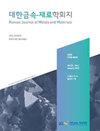Properties and Lightfastness of Natural and Artificial Azurite Used As Painting Pigment
IF 1.1
4区 材料科学
Q4 MATERIALS SCIENCE, MULTIDISCIPLINARY
引用次数: 0
Abstract
Azurite is an inorganic pigment commonly used in traditional painting arts and even today. This pigment has two types: natural azurite and synthetic artificial azurite, called blue verditer or blue bice. Because they have the same structure and similar appearance they are difficult to distinguish. The purpose of this study is to compare these two types pigments, focusing on material properties and accelerated weathering behavior. Natural azurite consist of copper carbonate and mineral compounds like quartz, kaolinite. On the other hand, artificial azurites are synthesized using azurite and calcite. As a result of thermal analysis, unlike natural azurite, the calcite in artificial azurite resulted in weight loss at three temperatures, at approximately 350 ℃, 650 ℃, and 840 ℃. According to the microscope analysis results, natural azurites have clearly blue angular particles with sharp edges, produced by crushing. Artificial azurite showed spherules and aggregates with tiny rounded or fibrous particles. After accelerated weathering tests, the natural azurites had no change in color, particle shape or original components, but the artificial azurites noticeably changed color and shape. The color changes of artificial azurites occurred due to the growth of calcite crystallite, a slight new product formation, and change in particle shape. Even though natural azurites are more expensive pigments, they provide superior color durability and particle shape stability compared to artificial azurites.天然和人工蓝铜矿颜料的性能和耐光性
紫苏石是一种无机颜料,常用于传统绘画艺术甚至今天。这种颜料有两种类型:天然天青石和人造天青石,称为蓝绿泥石或蓝碧石。因为它们具有相同的结构和相似的外观,所以很难区分。本研究的目的是比较这两种类型的颜料,重点关注材料性能和加速风化行为。天然天青石由碳酸铜和石英、高岭石等矿物化合物组成。另一方面,人工天青石是用天青石和方解石合成的。热分析结果表明,与天然天青石不同,人工天青石中的方解石在大约350℃、650℃和840℃的三个温度下都会导致重量损失。根据显微镜分析结果,天然天青石具有清晰的蓝色棱角颗粒,边缘锋利,是通过破碎产生的。人工天青石呈球状和聚集体,具有微小的圆形或纤维状颗粒。经过加速风化试验,天然天青石的颜色、颗粒形状和原始成分没有变化,但人工天青石明显改变了颜色和形状。人工天青石的颜色变化是由于方解石微晶的生长、轻微的新产物形成和颗粒形状的变化引起的。尽管天然天青石是更昂贵的颜料,但与人工天青石相比,它们提供了卓越的颜色耐久性和颗粒形状稳定性。
本文章由计算机程序翻译,如有差异,请以英文原文为准。
求助全文
约1分钟内获得全文
求助全文
来源期刊

Korean Journal of Metals and Materials
MATERIALS SCIENCE, MULTIDISCIPLINARY-METALLURGY & METALLURGICAL ENGINEERING
CiteScore
1.80
自引率
58.30%
发文量
100
审稿时长
4-8 weeks
期刊介绍:
The Korean Journal of Metals and Materials is a representative Korean-language journal of the Korean Institute of Metals and Materials (KIM); it publishes domestic and foreign academic papers related to metals and materials, in abroad range of fields from metals and materials to nano-materials, biomaterials, functional materials, energy materials, and new materials, and its official ISO designation is Korean J. Met. Mater.
 求助内容:
求助内容: 应助结果提醒方式:
应助结果提醒方式:


